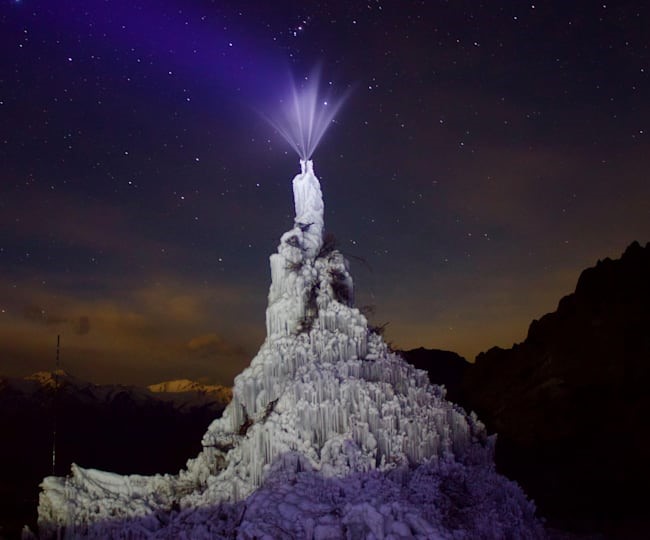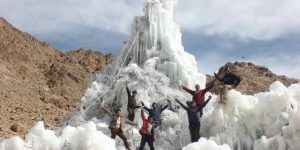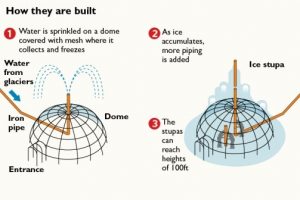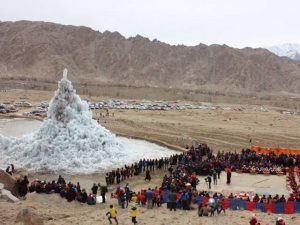
As Ladakh receives around 50-100 mm of meagre annual rainfall, glaciers have been their life saviours. But due to the adverse climatic changes in the recent decade, the glaciers have been melting at a fast pace. Due to these shrinking glaciers, people have to fight for every drop of water in the region. For this, they have come up with an extraordinary and beautiful way to preserve the water- the Ice Stupas.

What is an Ice Stupa?
During the winter months of January-February, people don’t utilize water as much hence, the melted streams flow through the Indus. During the hot months of April-May, everybody needs water in a massive volume. But as the melted water has already drifted away in the winter months, the people experience an acute shortage of water. Therefore, to store this winter water, Sonam Wangchuk invented these 30-50 m conical shaped ice, rising vertically upwards that doesn’t melt easily under the Sun. These ice mountains can be built right next to the village itself where the water is needed. Dreadfully diminutive energy or investment would be needed except for laying one underground pipeline from a higher point on the stream to the peripheries of the village.
The Ice Stupa Project

As mentioned above, Ladakh receives less rainfall and even the rate of snowfall has begun depreciating. This project started with a prototype to work on further. To examine this idea at SECMOL Alternative school, this prototype was built in a spot completely exposed to sunlight and located at the lowest altitude possible (warmest) in the Leh valley and that was at the bank of Indus, near Phey Village. This was to check if the stupa works in this extreme condition, then it can work anywhere. This prototype took a month to build around 7m (22 feet) in height, fed by the near campus supply pipe which had its head roughly 15 m above the spot. Their target date was 1st May 2014, but on 1st, there was still 3m of ice remaining and provided water around the area. It finally finished on 18th May, and hence, it was a successful experiment.
To celebrate this success, they invited His Holiness Drikung Kyabgon Chetsang Rinpochey, the head of the Drikung Kargyud lineage of Tibetan Buddhism, to visit their school and bless the Stupa. His Holiness invited SECMOL to build the fullscale version of the proto-type in Phyang village to solve the problems of water shortage an
How is an Ice Stupa Made?
According to Wangchuk, the principle is very simple. Firstly, they
 bring the prickly buckthorns that act as a skeleton to the Stupa. The water catches on to the thorns making it easier to crystalize on the cold surface. Wangchuk says, that the water always maintains its level. So, they bury a pipeline with its inlet some distance upstream and the outlet where they want the glacier to take place. This pipeline travels from the utmost heights to the lowest region, creating a difference in their water level. Since water maintains its level, the outlet of the pipe rises to almost the same height as the source and this requires no electricity, machines, only gravity. Due to intense pressure, water gushes out from the top of the outlet and sprinkles in small droplets, exposing it to -30 to -50 degrees Celsius, causing it to freeze immediately. Naturally, it takes a shape of a conical heap that results in an Ice Stupa.
bring the prickly buckthorns that act as a skeleton to the Stupa. The water catches on to the thorns making it easier to crystalize on the cold surface. Wangchuk says, that the water always maintains its level. So, they bury a pipeline with its inlet some distance upstream and the outlet where they want the glacier to take place. This pipeline travels from the utmost heights to the lowest region, creating a difference in their water level. Since water maintains its level, the outlet of the pipe rises to almost the same height as the source and this requires no electricity, machines, only gravity. Due to intense pressure, water gushes out from the top of the outlet and sprinkles in small droplets, exposing it to -30 to -50 degrees Celsius, causing it to freeze immediately. Naturally, it takes a shape of a conical heap that results in an Ice Stupa.
Also, to prevent the water to freeze while travelling through the pipe (which is very likely at -20 degrees Celsius), the pipes are inserted 4 ft underground, and at this distance, nothing can freeze. The water is slightly above the freezing line so that when it comes above, it freezes immediately.
How does an Ice Stupa Work?
Ice stupas are often constructed on top of streambeds, supplementing the communal water supply. One idea calls for water from the ice stupas to be collected in reservoirs or tanks connected to drip irrigation systems. The melted ice is collected into a collection tank. From here there’s drip irrigation, that goes all the way to the bottom, to the lands, and the plants receive water when they need it the most, during April-May to grow.
A 50 ft ice stupa can hold up to a quarter of a million water to supply to the village. The volume of water stored in these ice cones extends vertically upwards towards the Sun where they obtain scarcer of the Sun’s heat. Hence, they will take a much longer time to melt as compared to an artificial glacier of the same volume formed horizontally on a flat surface.
Cultural Significance of Ice Stupa
These stupas play a significant role in the culture of Ladakh because not only do they provide water for loving they also preserve the traditions followed by the citizens. Several villages have been transformed into ghost villages because of the shortage of water, and these places were once picturesque in their manner. If this water scarcity continues, either the population will become extinct or they’ll seek refuge in different parts of the country. This will not only result in many casualties but also attack their culture due to the migration. These stupas provide water which inhibits the lands from turning into barren dumps and when these lands get proper water supply, then the farmers will be able to grow agricultural products like apple, barley etcetera that will also add to their economy.
 Now Wangchuk is building a pipeline to build 50 more stupas, each supplying 10 million of water a year to 25 acres of land to irrigate. Word of this project has reached mountaintops across the globe. Last year, 2020, he built Europe’s first ice stupa in the Swiss Alps. And this year, he’ll work on refreezing a glacial lake in India to halt flash floods. Wangchuk hopes that if the locals adapt now, their descendants won’t become climate refugees.
Now Wangchuk is building a pipeline to build 50 more stupas, each supplying 10 million of water a year to 25 acres of land to irrigate. Word of this project has reached mountaintops across the globe. Last year, 2020, he built Europe’s first ice stupa in the Swiss Alps. And this year, he’ll work on refreezing a glacial lake in India to halt flash floods. Wangchuk hopes that if the locals adapt now, their descendants won’t become climate refugees.
We in the mountains are minorities, not just ethically but climate-wise. Things that work out in New York or New Delhi, do not work out in the mountains. We will have to find solutions to our problems.
– Sonam Wangchuk
Besides solving the water crisis in the region and reinhabiting these barren villages, these stupas have also become an important tourist attraction in Ladakh. He has won a Rolex Award in 2016 for his project and he is using his prize money to build a pan-Himalayan research University that’ll address their environmental concerns.
The Future of Ice Stupas
In 2015, Wangchuk succeeded to raise $125,000 on crowdfunding and created a 64 ft ice stupa. The water freezes into a cone, which resembles a Buddhist shrine (from where the name originated). In the year 2019, around 12 stupas were built with heights ranging from 60-80 m and last year in 2020, the number increased to a total of 26 ice stupas. These stupas are resulting effective due to the simplicity and the natural conical shape it which provides water for even longer periods than expected as the lesser surface area melts slower providing the water in the right amounts at the right time of the year.
The government has also associated itself with the project and with the collective efforts of the Ministry of Tribal Affairs and Wangchuk, the number of ice stupas in Ladakh are increasing. In the year 2013, the stupa was just in one village; today, there are 26 such ice stupas across Ladakh (after the government joined in 2019-20). As of now, Mr Sonam Wangchuk is preparing a pipeline to create 50 more ice stupas that will provide 10 million litres of water a year to the village.
By Harshita Pathak

